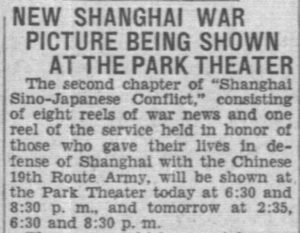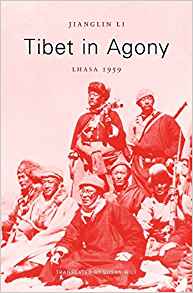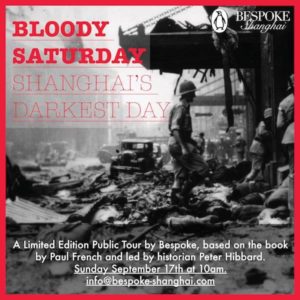Posted: September 28th, 2017 | No Comments »
Recently the enterprising chaps at Taiwan’s Camphor Press (producers of great hard copy and e-book reprints) bought Eastbridge Books, a specialist Asian publisher. They’re reviving the house and reissuing titles as e-books. Including BJ Elder’s The Oriole’s Song: An American Girlhood in Wartime China….

The Oriole’s Song is a love story — love of family, of entwined cultures, of life itself — during and after the turmoil of war. This beautiful recollection of an American girlhood in China during World War II is a continual delight with large insights and small moments made exqusite by delicate prose. On May 17, 1951, Dwight Rugh — a Yale-in-China representative for twenty years and one of the last Americans remaining in China after the Communist Revolution — was taken from his home in Changsha to a mass rally where he was denounced as an imperialist spy. Twenty-three years later, his daughter was one of the first Americans to enter China after it reopened to the West. Despite the fact that the Cultural Revolution was in full sway, she visited the site of her father’s “trial†and met with some of his friends and colleagues who had been compelled to participate in the proceedings. In this evocative and beautifully written memoir, BJ Elder tells the remarkable story of her family and what it was like for her, an only child, to grow up in China during the Second World War. Born in Hunan, hers was a childhood spent in two languages and “between two names.†In a remote river town, she shares the terrors and enthusiasms of her Chinese friends, hides from Japanese bombs, struggles over Chinese calligraphy, and spends enchanted summers in a hidden valley. Yet she thinks of America as “home.†When the family goes home to the United States, however, she finds herself drawn back to the country of her birth. This is an account of how one person has tried to make sense of the past, of being formed by two cultures yet never completely belonging to either, of seeing the world from one point of view, but feeling the presence of another, like print coming through from the other side of the page. In the end, two decades after the Cultural Revolution, she takes us “home†again to a much more open China, where she comes to terms with the past and with her place between the two worlds she has known.
Posted: September 27th, 2017 | No Comments »
The Mapping of Asia
A collection of fine antique maps from 16th to 20th century
including a group of city plans and nautical charts

Geographical Section General Staff, Hong Kong and Part of the Leased Territory (1913) 1920
The exhibition continues until 28th October 2017
Wattis Fine Art Gallery
Posted: September 26th, 2017 | No Comments »
This article popped on Atlas Obscura up recently on the history of the US Armed Forces edition paperbacks distributed to military personnel during WW2 between 1943-1946. It’s an amazing story and worth a read…
I should also mention that Carl Crow’s Four Hundred Million Customers was selected as a US Armed Forces edition and specifically issued to all the GIs and sailors that liberated Shanghai and were stationed there for several years afterwards rebuilding the city, country and running the War Crimes Tribunals.
 As far as I know Crow’s was the only China-related title in the series apart Alice Tisdale Hobart’s 1933 Oil for the Lamps of China…
As far as I know Crow’s was the only China-related title in the series apart Alice Tisdale Hobart’s 1933 Oil for the Lamps of China…

Posted: September 20th, 2017 | 2 Comments »
The people at Bespoke Beijing and Penguin China have gotten together to organise another nighttime walking tour (the official one!) based on my book Midnight in Peking….contact them for tickets and to RSVP…

Posted: September 19th, 2017 | No Comments »
During the Sino-Japanese conflict in Shanghai in the summer and autumn of 1932 pictures were rushed to the newsreels to be shown as fast as possible at cinemas – such as this one in Honolulu, Hawaii
 They advertised the newsreels as featuring ‘real battlefield scenes’. Several different newsreels covering Shanghai were running at different cinema chains in competition.
They advertised the newsreels as featuring ‘real battlefield scenes’. Several different newsreels covering Shanghai were running at different cinema chains in competition.
Posted: September 18th, 2017 | No Comments »
Sadly can’t be there, but do have an article in the Journal (the Lady Chatterley banned in Shanghai one noted below)…..
Launch of the newly published RAS China Journal

WHAT: Launch of the newly published RAS China Journal
WHEN: 7:30 PM – 9:00 PM Tuesday, September 26
WHERE: The Courtyard Institute, 28 Zhonglao Hutong (see map)
RSVP: email communications.ras.bj@gmail.com and write “journal” in the header. Please state name and number of people.
COST: free
Please join us on Tuesday, 26 September to celebrate the launch of the newly published Journal of The Royal Asiatic Society China, beginning 7.30 PM at The Courtyard Institute near Jingshan Park.
This latest edition of The Journal has 300 pages and 19 articles ranging from the censorship of Lady Chatterley in Shanghai to a history of rugby football in the Far East, from British diplomatic diaries during the 1900 Boxer siege to aspects of Chinese architecture, past and present. You’ll have a chance to meet RAS Journal Editor, Richard de Grijs, and some authors, and to mingle over wine and nibbles from Red Kitchen Cabinet .
Members in good standing — including those who join on the night — will receive a Journal free; others can purchase one for RMB 70.
You’ll also learn more about our program for the coming year. If you’ve enjoyed our activities, and always meant to join the Royal Asiatic Society Beijing, this is the time! Individual membership for the year costs RMB 300. Upcoming events will focus on a diverse range of topics, from the party congress to comparing Chinese and Western music to researching American aviators in WWII China.
We  hope to see you September 26. So that we have accurate numbers for catering, kindly RSVP to communications.ras.bj@gmail.com by Sept. 23.

Posted: September 14th, 2017 | No Comments »
A new study of the takeover of Tibet in 1959….

The Chinese Communist government has twice invoked large-scale military might to crush popular uprisings in capital cities. The second incident the notorious massacre in Tiananmen Square in 1989 is well known. The first, thirty years earlier in Tibet, remains little understood today. Yet in wages of destruction, bloodshed, and trampling of human rights, the tragic toll of March 1959 surpassed Tiananmen.
Tibet in Agony provides the first clear historical account of the Chinese crackdown in Lhasa. Sifting facts from the distortions of propaganda and partisan politics, Jianglin Li reconstructs a chronology of events that lays to rest lingering questions about what happened in those fate-filled days and why. Her story begins with throngs of Tibetan demonstrators who fearful that Chinese authorities were planning to abduct the Dalai Lama, their beloved leader formed a protective ring around his palace. On the night of March 17, he fled in disguise, only to reemerge in India weeks later to set up a government in exile. But no peaceful resolution awaited Tibet. The Chinese army soon began shelling Lhasa, inflicting thousands of casualties and ravaging heritage sites in the bombardment and the infantry onslaught that followed. Unable to resist this show of force, the Tibetans capitulated, putting Mao Zedong in a position to fulfill his long-cherished dream of bringing Tibet under the Communist yoke.
Li’s extensive investigation, including eyewitness interviews and examination of classified government records, tells a gripping story of a crisis whose aftershocks continue to rattle the region today.
Posted: September 12th, 2017 | No Comments »
Final chance to sign up for the last few places on the Bloody Saturday walk this coming weekend…
-










